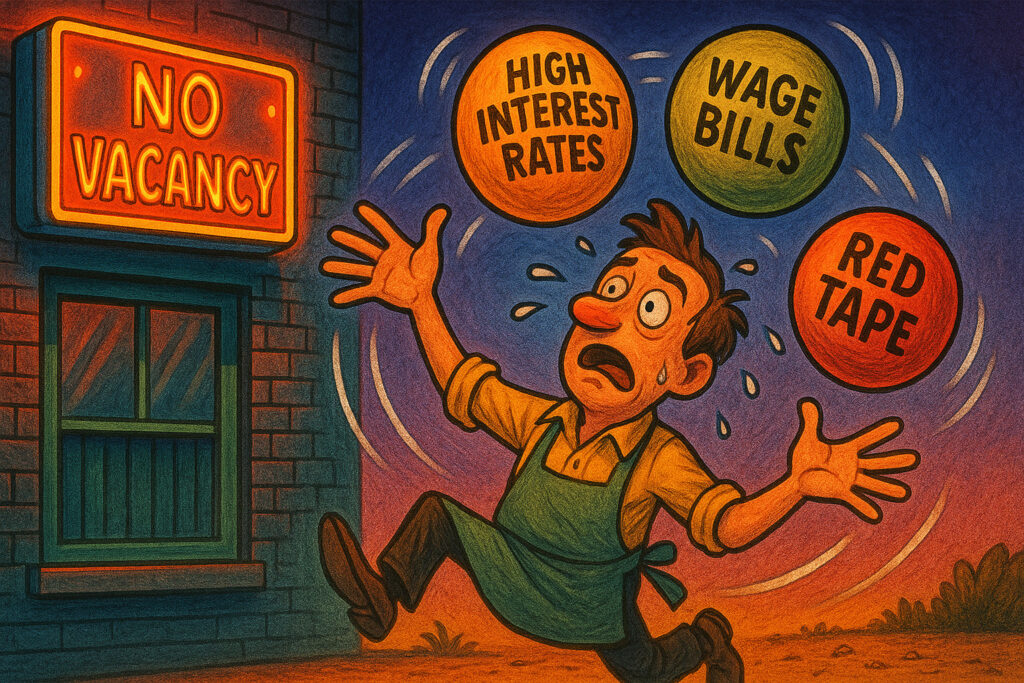Introduction
On July 9, 2025, the National Federation of Independent Business (NFIB) released its June Small Business Optimism Index, revealing a decline to 89.7 from 90.5 in May. The drop marked the third monthly decrease in a row and brought the index further below its long-term average of 98, underscoring persistent concerns among small firms about inflation, labor availability, and borrowing costs.
The data come at a pivotal time for the U.S. economy, with signs of labor market cooling and increased expectations for Federal Reserve rate cuts. Yet despite a more favorable macro outlook, small business sentiment continues to lag, weighed down by elevated input costs and uncertainty around regulatory and tax policies.
This article analyzes the latest NFIB survey results, explores market implications, and examines how small business trends may influence broader economic momentum and the Fed’s policy calculus in the second half of 2025.
NFIB Survey Highlights: Confidence Slips Further
The NFIB Small Business Optimism Index fell to 89.7 in June, missing consensus expectations of 90.2. The decline was broad-based, with multiple sub-indices showing deterioration:
- Plans to increase employment: Down 3 points to 14%
- Expectations of better business conditions: Fell 2 points to -44%
- Capital expenditure plans: Declined to 22% from 25%
- Earnings trends: Net -31%, near decade lows
- Current job openings hard to fill: Down to 37%, still historically elevated
While fewer firms reported raising prices, inflation remains a top concern for 22% of respondents. Concerns about interest rates also remained high, with 31% citing tighter credit conditions as a primary obstacle.
Labor Market Dynamics
Hiring intentions fell, and unfilled job openings remained stubbornly high. While labor market conditions are easing, small firms continue to report difficulty finding qualified workers—particularly in construction, transportation, and skilled trades.
Wage growth pressures have moderated slightly, with only 36% of firms reporting wage increases over the past three months, down from 42% in March. However, labor remains the most significant cost input for many small businesses.
The labor data align with broader macro signals of cooling employment, as shown in the June Nonfarm Payrolls report (+142,000 jobs) and the uptick in the unemployment rate to 4.2%.
Financing Conditions: Tight but Stable
Access to credit remains a pain point. The share of firms reporting that their borrowing needs were not satisfied rose to 12%, the highest since 2012. Interest rates on short-term loans remained elevated, with the average rate at 9.4%, compared to 6.2% a year earlier.
Higher borrowing costs have led many small firms to delay investments, curtail hiring, and reduce inventories. This restraint may weigh on GDP growth in Q3 and Q4 if it persists.
Inflation and Input Costs
Although inflation has moderated nationally, small businesses still report elevated input costs—especially for utilities, insurance, and raw materials. Some regional variation exists, with the South and West reporting higher price pressures than the Midwest and Northeast.
Energy-sensitive sectors such as agriculture and logistics continue to see volatility in fuel and equipment costs. Meanwhile, healthcare costs remain a rising burden for employer-sponsored plans.
Market Reaction: Equities and Rates Steady
Markets were little changed following the NFIB release, with investors more focused on upcoming inflation data and Fed commentary. The S&P 500 was flat at 5,361.22, while the Nasdaq dipped 0.2% to 17,043.78.
Treasury yields held steady, with the 10-year yield at 4.19% and the 2-year at 4.47%. The Dollar Index (DXY) was unchanged at 104.63.
However, sector-specific implications were noted:
- Regional banks and lenders may face increased loan loss provisions tied to small business defaults.
- Industrial REITs and commercial landlords are seeing slower leasing activity among smaller tenants.
Fed Outlook: Data Adds to Case for Caution
The NFIB report adds to the narrative of a two-speed economy: large corporations are generally resilient, while smaller firms continue to struggle with cost pressures and constrained demand.
Fed officials have acknowledged this divergence. Atlanta Fed President Raphael Bostic and Dallas Fed President Lorie Logan both referenced small business sentiment in recent remarks, suggesting it remains a key input to their policy view.
With inflation moderating and labor cooling, the latest data may strengthen the case for a September rate cut—provided upcoming CPI and PPI readings confirm the disinflation trend.
Conclusion
The June NFIB Small Business Optimism Index’s decline to 89.7 highlights persistent fragility among U.S. small firms despite an improving macro backdrop. Elevated borrowing costs, tight labor markets, and stubborn input inflation continue to weigh on confidence, hiring, and investment.
While markets remain focused on broader indicators and central bank signals, the weakness in small business sentiment offers an important cautionary signal. These firms account for nearly half of U.S. private-sector employment and are often early indicators of economic turning points.
Investors and policymakers alike will be watching:
- July’s CPI and PPI data (due July 11–12) for confirmation of disinflation
- Fed Chair Powell’s July 10 remarks for signals on upcoming rate policy
- Q2 GDP and earnings data for signs of small business contribution to growth
If small business weakness persists into Q3, it could accelerate Fed easing and shift the narrative from resilience to pre-recession caution. In that context, defensive equity positioning, selective credit exposure, and liquidity-focused strategies may gain prominence.
